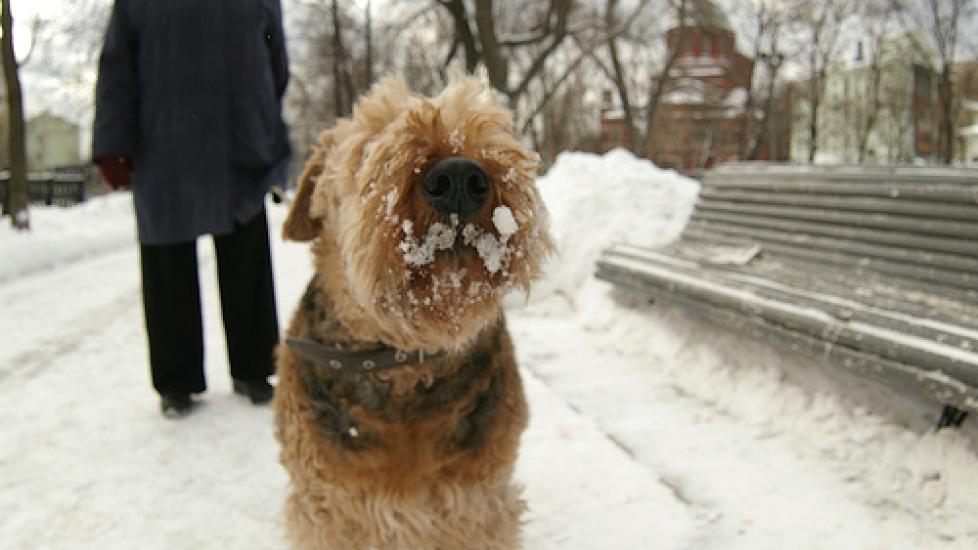Winter Walking Dangers for Cats and Dogs
If your dog or cat spends any amount of time outdoors, winter can be a particularly dangerous time. While the freshly fallen snow can make the world appear as a winter wonderland, there are a lot of hidden hazards to be aware of. Ice covered sidewalks, chemicals scattered across driveways and walkways, these conditions can be hazardous to animals and humans alike. Keep yourself and your pet safe this winter season by being aware and taking precautions.
Chemicals on the Ground
It is common practice to apply chemicals to sidewalks and driveways so that the ice can be made to melt, or just to make it so that the feet can grip the ground easier. The problem with these chemicals is that they get onto animals’ unprotected feet, where they can irritate the skin or get into small abrasions in the foot pads. The animal may also lick the chemicals off of their feet and ingest them, resulting in stomach and intestinal problems. There are products that are relatively safe for animals, but not everyone uses a pet-friendly product for their sidewalks and driveways.
One solution is to outfit your dog with a set of booties, so that the foot pads are protected. Booties are also good for keeping hard snow and ice out of the spaces between the toes, something that can be very painful for an animal.
If your pet will not tolerate wearing booties, you will need to be vigilant about cleaning your pet’s feet and underside as soon as you return home from a walk. A simple rag that has been dipped in warm water will do the job.
It is also a good idea to make a habit of checking your dog or cat’s feet on a regular basis after they come in from outside to be sure that the footpads and toes are clean and free of abrasions.
Ethylene Glycol (Antifreeze) Poisoning
Another common winter practice is the changing of antifreeze/coolant in the car engine. There will always be unintentional spills to watch out for, and not everyone is conscientious about cleaning up the spills in the driveway or on the garage floor. While a lot of companies have changed the formula of their antifreeze products so that they do not have a sweet taste, there are still plenty of antifreeze products on the market that do have that tempting sweet smell and taste to them. Dogs and cats, of course, do not know any better, and they lap up spilled antifreeze solutions when they find them on the ground.
The main ingredient of most antifreeze solutions is ethylene glycol, an extremely toxic chemical that leads to a lot of accidental illnesses and deaths in pets every year. If there is no one around to witness the pet ingesting antifreeze and the symptoms are not treated immediately, the animal may suffer severe nervous system and kidney damage within a short period after ingestion. Even the newer pet-safe products have a degree of toxicity, and the only way to avoid accidental poisoning is keep the products out of reach of pets, and off of the ground.
All antifreeze products need to be carefully secured in an area that is out of reach for pets – and children, for that matter. All spills should be cleaned immediately using a water hose or similar procedure. In addition, if you are out walking and see a puddle in the street or on a driveway, do not let your pet walk through it or drink from it.
If you suspect that your pet has ingested even a small amount of antifreeze, the best thing you can do is call your veterinarian or local emergency animal clinic immediately. Ethylene glycol is a fast acting chemical, and minutes can make a difference.
Frostbite
Your pet may not be complaining about the cold, and is probably even having a blast playing in the snow, but just like us, animals do not always notice that their skin has started to feel funny. As the body’s temperature decreases in response to the outdoor temperature, blood is diverted to the core systems, leaving the outer organ, the skin, at risk of freezing. Once the skin has been frozen by the ice and snow, there is tissue damage, basically causing a condition akin to burning. At highest risk for frostbite are the footpads, nose, ear tips and tail.
Upon returning home after being outdoors for an extended time, or when the temperatures are especially low, check your pet’s risk points (along with the rest of the body). Early symptoms of frostbite include pale, hard skin that remains very cold even after being inside. As the skin warms, it may swell and change to a red color.
Your pet may try to relieve the irritation by licking and chewing on the skin, in which case you will need to have the skin treated and covered immediately before permanent damage is done.
Never apply direct heat to the skin, water or otherwise. Only tepid to warm water should be used on the skin, and non-electric blankets to cover the animal. You may need to consult with a veterinarian to make sure that the condition is not severe.
In some cases of severe frostbite the tissue needs to be removed, or the limb removed before the dead tissue allows infection to set in.
--
Hopefully, this has educated you and not frightened you. These are just some of the ways you can protect your pet, so that you do not need to worry yourself over anything, and so that you and your pet can have a great time in the snow and on the ice.
Image: Adam Baker / via Flickr
